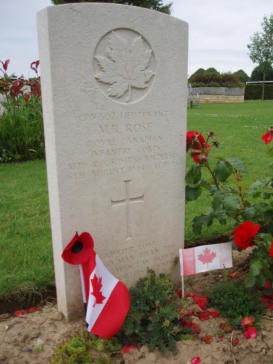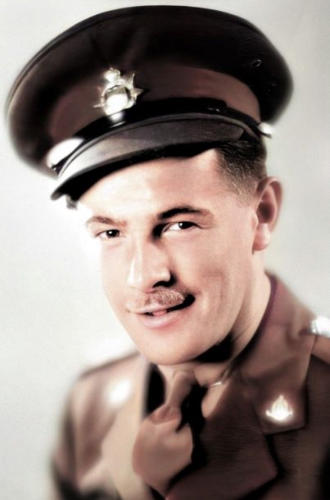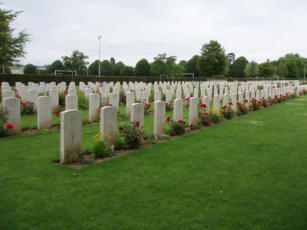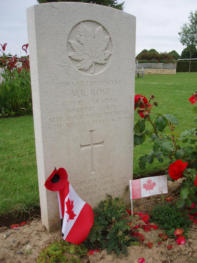Bayeux War Cemetery

copyright © Wartime Heritage Association
Website hosting courtesy of Register.com - a web.com company
Wartime Heritage
ASSOCIATION
Remembering World War II
Yarmouth Connections

Name:
Malcolm Rudolph Rose
Rank:
Lieutenant
Service No:
CDN/502
Service:
1st Battalion, the King's Own Scottish Borderers
3rd “Iron” Infantry Division, British Army
Date of Birth:
June 24, 1918
Place of Birth:
South Chegoggin, Yarmouth Co., NS
Date of Enlistment:
June 10, 1941
Place of Enlistment:
Yarmouth, NS
Address At Enlistment:
South Chegoggin, Yarmouth Co., NS
Age at Enlistment:
22
Height: 5 feet, 4 inches
Weight: 128 lbs
Complexion: Fair
Eyes:
Blue
Hair: Black
Previous Military
F44531 2nd Battalion, West Nova Scotia Regt.
(Training November 22 - December 20, 1940)
Trade:
Dairyman
Marital Status:
Single
Religion:
United Church of Canada
Next of Kin:
Mrs. Margaret Rose (Mother) South Chegoggin, Yarmouth Co., NS
Date of Death:
August 6, 1944
Age at Death:
26
Cemetery:
Bayeux War Cemetery (Calvados, France)
Grave Reference:
XVI. B. 24.
The 99th name on the WWII list of the Yarmouth War Memorial
Commemorated on page 432 of the Second World War Book of Remembrance
Displayed in the Memorial Chamber of the Peace Tower in Ottawa on September 19
Lieutenant Rose was the son of George Edward and Margaret Mae Rose, of South Chegoggin, Yarmouth Co., Nova Scotia. He
attended the Yarmouth Academy and completed grade 11 at the age of sixteen and left school to go to work. He completed a
Commercial course in bookkeeping, shorthand and typing. He worked on the farm with his father, was employed as a service
station attendant for Irving Oil [1937-1939] and worked on a milk delivery route for Yarmouth Ice Cream and Diary Company,
Yarmouth [1939-1940]. He was an exceptionally good athlete taking part in baseball, hockey, basketball, bowling and swimming.
His intention was to return to farming upon completion of his war service.
He completed his basic training at No. 60 CABTC Yarmouth. He was appointed
Acting Sergeant at Yarmouth in 1942 and qualified for officer training and
transferred to Halifax in November, 1942. He continued training at 3 Rivers,
Quebec and at Aldershot, NS promoted to Lieutenant in March 1944. On June 2,
1944 he disembarked in England as a CANLOAN Officer.
He served in Canada between June 10, 1941 and May 5, 1944, in the United
Kingdom between May 5, 1944 and July 5, 1944, and in France between July 6,
1944 and August , 1944. Lieutenant Rose was a member of the Royal Canadian
Infantry Corps. He died while serving with the King's Own Scottish Borderers as a
CANLOAN Officer. He was in the 1st Battalion of the King’s Own Scottish Borderers
(3rd “Iron” Infantry Division). He was killed in action on August 6, 1944.
Sources and Information:
Unlocking the Mystery of a Name
Commonwealth War Graves Commission
Veterans Affairs Canada
findagrave.com
Malcolm Rudolph Rose

Photo: Wartime Heritage

Wartime Heritage
MALCOLM RUDOLPH ROSE The 99th Name on the World War II YARMOUTH WAR MEMORIAL BAYEUX WAR CEMETERY France Malcolm Rose served as a Lieutenant with the Royal Cana dian Infantry Corps. He died at the age of 26 on August 6th, 1944 while serving with the 1st Battalion of the King’s Own Scottish Bor derers (3rd “Iron” Infantry Division) as a CANLOAN Officer. The town of Bayeux, in Normandy, lies 24 kilometres north west of Caen. Bayeux War Cemetery is situated in the south-western outskirts of the town. The Allied offensive in north-western Europe began with the Normandy landings of 6 June 1944. There was little actual fighting in Bayeux although it was the first French town of importance to be liberated. The Bayeux War Cemetery is the largest Commonwealth cemetery of the Second World War in France. and contains 4,144 Commonwealth burials of the Sec ond World War, including 181 Canadians, among them "CANLOAN" officers, young Canadians lent to the British Army. In early 1944 the British military were short of officers and Canada had a surplus. Lieutenants and Captains of the Canadian military were asked to go on loan to the British Army. Under the CANLOAN plan, some 6,223 infantry and 50 ordi nance officers were attached to the British army. These officers received a month of special training and assessment at Sus sex, New Brunswick before being sent to Britain. The first of the officers on loan arrived in the British Isles early in April 1944. The last group arrived late in July. The infantry officers were attached to about 60 different British regiments. Some of the CANLOAN officers landed in Normandy on D Day, June 6, 1944. Most went i nto the Normandy Campaign during the summer and fall of 1944. 1st King's Own Scottish Borderers crossed to France on D-Day, June 6th, 1944, landing at ‘Queen’ Beach. They fought around Caen until the town capitulated on July 9, 1944. In early August of 1944 the 1st King's Own Scottish Borderers encountered the German resis tance near Estry in Normandy. Heavy fighting continued around Estry between August 5th and 8th. On August 5th the Germans crossed Estry under heavy shelling of the British artillery and on August 8th German artillery stormed Estry to prevent the British from entering the town. The battle ended in this area of France on August 13th when the Germans pulled back. A monument stands in Estry, France in memory of the 1st Battalion King's Own Scottish Bor derers, of the 9th Brigade (3rd British Infantry Division) who participated in the liberation of the town in August 1944. The final resting place of Malcolm Rose is found among the thousands who gave their lives during the Normandy Campaign and are buried in the Bayeux War Cemetery. The red roses that adorn the stones are perhaps most appropriate to those who served in the King's Own Scottish Bo rderers. The King's Own Scottish Borderers are one of the six infan try regiments which 'gained immortal glory' at the Battle of Minden in 1759 by advancing against a superior force of French Cavalry. This battle commemorated annually on August 1st when the Regiment wear red roses in their headdress following the tradition that the soldiers had picked roses as they advanced through gardens before the battle. This custom was observed by Borderers in 1944 when they mounted an attack on Minden Day during the invasion of Nor mandy - for they attached to their helmets the roses which they plucked from the hedgerows. On July 10th, 2009, members of the Wartime Heritage Asso ciation visited Bayeux Cemetery and placed a Canadian flag and poppy at the stone of Malcolm Rose. Published by the Wartime Heritage Association (2009)




- World War I - Menu
- WWI Stories and Articles
- Photos - Yarmouth Soldiers
- Selection of World War I Songs
- WWI Casualties of Yarmouth, NS
- Those Who Served - Yarmouth, NS
- WWI Casualties Digby Co. NS
- WWI Casualties Shelburne Co. NS
- Merchant Mariners (1915) Yarmouth, NS
- Canadian Forestry Corps - Non Yarmouth Birth/Residence Enlistments
- US Draft Registry - Yarmouth NS Born


- World War II - Menu
- WWII Stories and Articles
- Telegraphist Air Gunners
- WWII Casualties of Nova Scotia
- US Casualties with NS Connection
- Far East/Pacific Casualties with NS Connection
- Merchant Navy Casualties Nova Scotia
- Nova Scotia WWII Casualties Holten Canadian War Cemetery
- D-Day Casualties - Nova Scotia
- CANLOAN Program Casualties - Nova Scotia
- Battle of the Bulge Casualties - Nova Scotia
- WWII Casualties Yarmouth NS
- Yarmouth Casualties - RCAF RAF Canadian Army WWII
- Yarmouth Co., Marriages WWII
- Casualties Non-Born/Residents with Connection to Yarmouth Co., Nova Scotia.
- WWII Casualties Digby Co., NS
- Non-Nova Scotian WWII Casualties Buried in Nova Scotia
- WWII RCAF Casualties Aged 16-18
- Brothers/Sisters Who Served - World War II














